Brooklyn
Brooklyn, the "Borough of Homes and Churches," is one of the five boroughs of New York City. It used to be a separate city, and still feels much like one. It has about 2.5 million inhabitants. If separated from the rest of New York City, Brooklyn would be the 4th most populous American city.
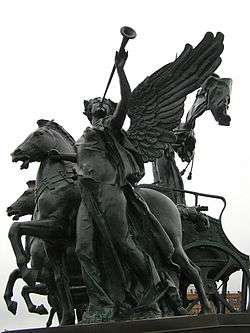
Brooklyn is on the westernmost point of Long Island and shares a land boundary with Queens, which partially encircles Brooklyn to the north, east and south; Manhattan lies across the East River to the west and north of Brooklyn, and Staten Island is across the Verrazano-Narrows Bridge to the southwest.
Brooklyn is enjoying a period of growth and affluence not seen since before World War II. The Brooklyn Academy of Music boasts world-class theater performances, and the nearby Barclays Center is the home of the NBA's Brooklyn Nets. Coney Island's Luna Park is one of the attractions for summer crowds seeking fun during the New York summer heat.
Downtown Brooklyn been undergoing extensive redevelopment and now boasts upscale boutiques, abundant public spaces, and the Brooklyn Bridge Park stretching along the waterfront and providing unparalleled views of New York City skyline. Prospect Park, a national historic site, was even preferred by its designer Frederick Law Olmsted to his other creation, Manhattan's Central Park. Williamsburg has been named by Forbes magazine as one of America's Best Hipster Neighborhoods. Brighton Beach is home to New York's largest concentration of Russian immigrants, while the growing 8th Avenue Chinatown paints a more authentic picture of New York's Asian community than its counterpart in Manhattan. However, despite these developments, Brooklyn is full of old gems, like family-owned brick-oven pizzerias, dive bars that seemingly haven't changed since 1950s, and vast historical neighborhoods with buildings dating back to Dutch colonial times.
Districts
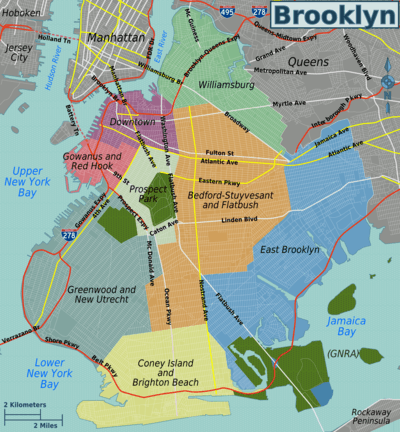
| Williamsburg Well known for its large artistic community, it is a diverse area with hipsters centered around Bedford Avenue, Orthodox Jews in South Williamsburg, a sizeable Polish population in Greenpoint, and a large Hispanic population and a growing arts community in Bushwick. |
| Downtown The main tourism district in Brooklyn, Downtown Brooklyn has majestic buildings, the Brooklyn Bridge, and an unparalleled view of the Manhattan skyline. |
| Gowanus and Red Hook While it used to be known for a high crime rate, Red Hook has become an artists' colony and was home to MTV's Real World Brooklyn cast. The nearby areas of Gowanus and Carroll Gardens are good places to explore some of Brooklyn's industrial history. |
| Prospect Park Pretty brownstone houses, the Brooklyn Museum, the Brooklyn Botanical Gardens, and more, all ringing Olmstead and Vaux's preferred park. |
| Greenwood and New Utrecht The big attraction is the historic Green-Wood cemetery, one of the largest in New York and the final resting place of several notable people. Other attractions include New York's third Chinatown and an Italian enclave in the west of Brooklyn. |
| Bedford-Stuyvesant and Flatbush The beating heart of Brooklyn is home to New York's largest African-American neighborhood, many West Indian immigrants, a large Orthodox Jewish community, mighty shopping streets, beautiful Victorian homes, and much of the classic history of Brooklyn. |
| Coney Island and Brighton Beach Home to the fabled Coney Island amusement parks. The neighborhood has seen a rise in tourism with the opening of the brand-new Luna Park amusement park. Also home to New York's only aquarium, the Cyclones minor league baseball team, the original Nathan's restaurant, and one of the largest Russian-speaking communities outside the former USSR. |
| East Brooklyn While certain neighborhoods in this section are pretty rough and this one is off the average tourist's radar (except for its proximity to JFK), this section has some attractions near Jamaica Bay. |
There are a variety of neighborhoods in Brooklyn. Small Town Brooklyn has a scrollable map of many of them:
- Downtown Brooklyn, which is the central shopping and business area, anchored by Fulton St. west of Flatbush Avenue, looks similar to the downtown of almost any other major American city, with department stores, clothing and electronic shops, Borough Hall, two universities, a major railroad station, the Brooklyn Academy of Music concert hall, many office buildings, and municipal, state and federal buildings and courthouses. Many subway and bus lines go to or through Downtown Brooklyn.
- Brooklyn Heights is a residential neighborhood with elegant buildings and historic churches. It is an expensive neighborhood to live in, partly because of its great views of the Lower Manhattan skyline. The area's brownstone buildings and shopping district give it a quaint yet thriving feel. This is the richest neighborhood in Brooklyn, more expensive than parts of Manhattan.
- Canarsie is a West Indian neighborhood with somewhat of a "small-town" feel, largely composed of 1- and 2-family houses. The major commercial streets are Flatlands Avenue, Rockaway Parkway and parts of Seaview Avenue. It is served by the Rockaway Parkway station on the L line.
- Cobble Hill is a quiet neighborhood of bookstores, shops, and restaurants. Old-time Italian neighborhood with great pizza and Italian ices. Great restaurants and quite a number of bars along Court St. and Smith St.
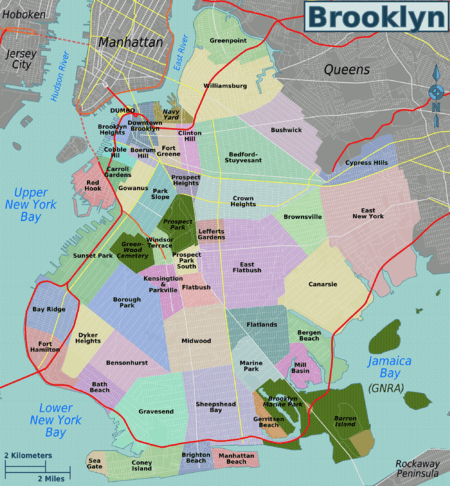
- DUMBO is an acronym for Down Under the Manhattan Bridge Overpass. Once popular with artists for loft space, it has now become popular with a richer, trendier crowd. Walk along the riverfront park for a unique and unforgettable view of the Brooklyn and Manhattan Bridges and the Manhattan skyline.
- Park Slope- Long a haven for interracial families, lesbians and gays, and everyone else with a certain kind of groove in NYC, this upscale but downhome neighborhood can be joked about as the Berkeley of New York City. The granola eating transplant crowd might make you queasy at times and nostalgic for crackheads, but the neighborhood itself is beautiful. Boutiques, cafés, bars, health food stores like the 30-year-old Park Slope Food Coop, and attractive young people pushing strollers. Also home to a sizeable Lesbian community since the 1970s. Take the B or Q to 7th Ave, the M or R to 9th St, or the F or G to 4th Ave. or 7th Ave. and walk the neighborhood. Prospect Park is large, beautiful and green. Ice-skate here in the winter. Fly kites and enjoy free weekend concerts in the summer. While staying hip and vibrant, "the Slope" as it is commonly referred to, also enjoys its share of wealth. The quaint, tree-lined streets closer to the park house ornate, brownstones, townhouses, full service apartment buildings, and even a few full scale urban mansions on the parkside. These residences include the homes of names such as Senator Charles Schumer (D-NY) and famed actors Jennifer Connelly, Steve Buscemi and Maggie Gyllenhaal. Check out 5th Ave. for the restaurants and bars.
- Carroll Gardens- Historians date the name to the 1960s, and real estate people like to enlarge its borders. It encompasses part of Smith St. and the nearby areas. In the 1950s and further back in time, this area was known as Red Hook, to the dismay of many, and it still is called both Red Hook and South Brooklyn by many people. Smith St. has a newly charged restaurant row, but there are still plenty of old school Italian-American gems to be found.
- Williamsburg- Take the L train from Manhattan to Bedford Ave. or Lorimer St. Many restaurants, several popular music clubs and a burgeoning art gallery district. It is now what Greenwich Village used to be - including the artsy scene complete with eclectic galleries and off-beat bars. Have dinner at Sea (North 6th St. & Bedford Ave.) and go to the Royal Oak for a drink (North 11th St. & Union Ave).
- East Williamsburg- Centered around the Morgan Ave. stop on the L train. Seemingly a desolate industrial area, this neighborhood has a strong developing music scene. It is also home to the swinger's club Grego's. Brooklyn's natural food store can be found here.
- Bushwick- Rich in its own history, Bushwick is home to many brownstones, mansions, and projects alike. As a low-income neighborhood, shopping can be done on Knickerbocker Avenue, whether for clothes, appliances, or food. The newly restored Maria Hernandez Park on Knickerbocker Ave. and Suydam St. is a nice spot to bring the kids and relax in the shade of the trees. While it's not like neighboring "East Williamsburg," Williamsburg, or Bedford-Stuyvesant, Bushwick has its own sense of community, not to be confused with anything else. However, violent crime is a still a concern along with the other social problems in the community associated with the high poverty rate.
- Prospect Heights- Situated just north and northeast of Prospect Park, Prospect Heights features the Brooklyn Museum, which is first rate but often overlooked due to the museums in nearby Manhattan; a block away from the museum is the Brooklyn Botanic Garden. Further west on Eastern Parkway are the Brooklyn Public Library and Grand Army Plaza, the southern point of which marks the main northern entrance to Prospect Park.
- Red Hook is a formerly bustling industrial area that is on the upswing. Although hard to access by train, it can be served by the F & G trains at Smith-9th Street or by taxi or by the B61 bus. Settled in 1636 by the Dutch, it has seen many a boom and bust is today caught between those who like it as the sleepy part of town that time forgot and those who seek to restore its crown as the Queen of Kings County Commerce. If you're looking for something off the beaten path, Red Hook is it. Many artists call Red Hook their home, so don't be surprised to see random sculptures, galleries, or creative gardens across from city housing or burned out buildings. It was also home to the MTV's Real World Brooklyn cast in 2007. However, due to a massive low income public housing project that houses most of the neighborhood's residents, precautions should be taken. Violent crime, including robbery, is a problem in the community.
- Cypress Hills- A subsection of East New York. See East New York.
- Fort Greene has some great restaurants and the Brooklyn Academy of Music, which features an art-house cinema, theater, and concerts.
- Coney Island. Ah, the famous Coney Island. Take the D, F, N, or Q trains to the end of the line to enjoy the beach or amusements or just get your official Nathan's hot dog. The Cyclone, a 1927 roller coaster, is the most famous of the amusement park rides at Coney Island, for good reason: It packs a lot of thrill into a small lot. There is also a great view of Manhattan from the top of the Wonder Wheel (a large ferris wheel). Otherwise, the amusement park is somewhat seedy, which is part of its appeal. The high concentration of public housing projects in the area does make the neighborhood around the amusement park somewhat unsafe. Precaution should be taken while exploring these areas.
- Brighton Beach - The largest Russian-speaking community outside of the former USSR. It's unlike any other neighborhood in the city. It can be reached by the Q (local) or B (express) trains by going to Brighton Beach Avenue. Mosey on along the famous boardwalk and have a shashlik (shish-kebob) with a shot of vodka for lunch.
- Bay Ridge- Traditionally a residential Irish-Italian-Norwegian neighborhood, Bay Ridge has had an influx of Arab, Asian and Russian families as well. The Verrazano-Narrows Bridge connects to Staten Island, and Fort Hamilton, a United States Army Base, is here as well. There is a great variety of good values in food to be had in this neighborhood, especially on 3rd Av. Also, it is one of the top bar areas in the non-downtown area of Brooklyn.
- Sunset Park- Called New York City's little Puerto Rico and Brooklyn's Chinatown. Sunset Park is one of the most diverse neighborhoods in New York City. Less than 20 min from downtown Brooklyn, Sunset Park is a place for all families to come and shop and run Irene's on the heart of Sunset Park, 5th Avenue between 60th and 44th Streets. Its hilly terrain gives magnificent views of Downtown Brooklyn and Manhattan, Staten Island, Jersey City and the nearby Verrazano Bridge. Besides the Hispanic part of the neighborhood, filled with families from Puerto Rican, Dominican, Mexican and other Hispanic descent, the Chinese also put Sunset Park on the map with countless Chinese restaurants found on 8th Avenue between 60th and 40th Streets. Besides the diversity, Sunset Park also has a severe drug problem. It was the site of the August 8, 2007 Brooklyn tornado; at least 40 buildings and 100 cars were damaged.
- Greenpoint- At the northern tip of Brooklyn, Greenpoint is the second largest Polish enclave in the United States (after Chicago) but is also home to a sizable Latino population (north of Huron St.) and a growing number of hipsters (see Franklin St.). Get Polish food at Karczma (136 Greenpoint Av.), coffee at Ashbox (Manhattan Av. between Ash & Box Streets), brunch at Brooklyn Label (Franklin & Java), Mexican at Acapulco's (Manhattan & Clay). Lots of good Polish meat markets along Manhattan and Nassau Avenues, too. For some industrial chic, walk down Java Street to its dead end at the East River for great views of Midtown. Nearest subway: G train to Nassau Av. and Greenpoint Av. stations.
- Flatbush- Formerly a Jewish, Italian, and Irish neighborhood, and before that settled by members of the Dutch Reformed Church, and now a largely West-Indian neighborhood, it is the home of Brooklyn College, one of the most beautiful campuses in the area. In the very center is the 18th- century Dutch Reformed Church at the corner of Flatbush and Church Avenues, and the original school house dating to 1787 and originally called Erasmus Hall, now the administration building of the public Erasmus Hall High School, its own building over 100 years old. The neighborhood's eponymous commercial main street, Flatbush Avenue, goes from the Manhattan Bridge on the north to the Gil Hodges Marine Parkway Bridge leading to the Rockaway Peninsula section of Queens on the south. Get there by taking the 2 or 5 trains to Church, Newkirk, or Flatbush Avenue.
- Midwood is a quiet residential area with some commercial streets, on the other side of the Brooklyn College campus from Flatbush and extending for some distance to the south. The neighborhood is ethnically mixed but includes a substantial population of Modern Orthodox Jews and some Chasidim, and many shops are closed on Saturdays and Jewish holidays. The area has one of New York City's largest concentrations of beautiful free-standing hundred-year-old Victorian and Edwardian homes. An interesting example is the Avenue H station house on the Q subway line, which was built a century ago as the local real estate office selling these homes. It is a historic site and a unique fixture among the city's subway system. (See The Little Station House in the Woods for more information.)
- Sheepshead Bay - Near the Coney Island amusement parks, this neighborhood is populated with many Chinese and Russian immigrants. There are piers along the bay on Emmons Avenue where anyone can pay a small fee to be taken out for a day of fishing. Includes restaurants along the Bay and the El Greco Diner. It is served by the B & Q trains.
- Bensonhurst used to be Italian as far as the eye could see, but it now contains Albanian, Pakistani, Korean, Chinese, Mexican, and many Eastern European immigrants as well. Nonetheless, it is still the center of Brooklyn's Italian community and is one of the most well known Italian-American neighborhoods in the United States. The train runs above ground, and it is a lively place with an Old New York feel. Many of the best "unknown" restaurants in Brooklyn (known locally but often ignored by the Manhattan-based establishment) can be found in Bensonhurst. Get there by taking the D or M train to 18th or 20th Avenue or Bay Parkway.
- Crown Heights is largely a mixture of West Indians and Chasidic Jews. Get there by taking the 3 or 4 trains to Utica Avenue. Part of the neighborhood is near the Brooklyn Botanic Gardens and the Brooklyn Museum. Violent crime is a still a concern along with the other social problems in the community so use caution.
- Borough Park contains the biggest Chasidic Jewish community in the city. You will see lots of kosher foods on sale and shops that are closed every Friday night and Saturday, because of religious rules, but open on Sunday. If these things are unfamiliar to you, a trip to Borough Park may be worthwhile.
- Bedford-Stuyvesant is a major African-American neighborhood with some African presence. It is served by the A and C trains at Nostrand Avenue. It is the second largest African-American neighborhood in the country after the city of Detroit. Bed-Stuy, as it is called by most New Yorkers, has been gentrifying lately. However, violent crime is a still a concern along with the other social problems in the community.
- East New York- like many Brooklyn neighborhoods it is rich in its own history with homes where farms once stood and its many parks like Highland Park where children can roam free to play. Gateway Mall is one of the few suburban-like malls in the city. The City Line subsection and Liberty Avenue are where residents can shop for food and clothing. But with the mall, parks and new homes popping everywhere come the projects. Like Brownsville, East New York is one of most dangerous communities in New York City. Beware passing through here on your way to JFK Airport on the A and J trains and B15 bus.
- Brownsville is another mainly African-American neighborhood. It is just to the west of East New York, and like East New York, it remains among the more dangerous neighborhoods in New York, though crime statistics have declined, and does not merit a visit from most tourists. Beware passing through here on your way to JFK Airport on the B15 bus.
- Kensington is south of Prospect Park. It is the most diverse neighborhood in Brooklyn and is one of the most diverse in the United States. It is one of the "up and coming" neighborhoods in Brooklyn. Many new trendy restaurants and boutiques have opened, making this neighborhood a "hotspot" to reside in. It is served by the F and G trains at Church Avenue, the F at Ditmas Avenue, and the Q train at Beverly Road or Cortelyou Road.
Understand
The borough of Brooklyn is coterminous with Kings County—the counterpart of Queens County to the north—but hardly anyone calls it that except in occasional official correspondence.
Brooklyn was once a separate city independent of the City of New York. The cities merged at the end of the nineteenth century, forever after lamented by Brooklynites as "The Great Mistake of 1898." Although Brooklyn is very diverse, what makes Brooklyn so different from the other boroughs are its distinct cultural neighborhoods. Manhattan is frequently referred to as "the city" by residents of the other boroughs — for example, in the phrase "I'm going to the city." Many Brooklynites have a great deal of pride in their borough, and most New Yorkers consider Brooklynites to have an identity distinct from that of other New Yorkers. In any case, remember while speaking to Brooklynites that referring to Manhattan as "the city" is acceptable but calling Manhattan "New York City" is not. Be careful not to confuse Brooklyn and the Bronx - they are very different parts of New York City.
Visitor Information
- Brooklyn Tourism & Visitors Center, Historic Brooklyn Borough Hall, 209 Joralemon St, Ground Floor (at Court St; Subway: 2/3/4/5 trains to Borough Hall, M/R trains to Court St-Borough Hall, or A/C/F trains to Jay St-Borough Hall), ☎ +1 718 802-3846. M-F 10AM-6PM. Official tourist and visitor information center and gift shop with unique Brooklyn souvenirs.
Get in
By subway
From Manhattan
Most lines pass through Downtown Brooklyn and stop at Atlantic Avenue - Barclays Center, the largest subway stop outside Manhattan. From here, you can transfer between 2 3 4 5 B D Q N and get to almost any destination in Brooklyn. You can also walk about two blocks north of the station to find Fulton Street G and Lafayette Avenue C stations. To use these, however, you have to pay another fare or have an unlimited rides card.
For northern parts of Brooklyn, the L crosses into Williamsburg and Bushwick, then continues further east. The J Z M lines will get you to those same neighborhoods but a bit further south.
From Queens
There are four lines you can take to get directly from Queens to Brooklyn. The G snakes from Long Island City through Williamsburg and Downtown Brooklyn before ending near Prospect Park. Although it's seemingly the most direct route from Queens to Brooklyn, the service is notoriously slow and irregular, to the point where sometimes it's faster to get to Brooklyn through Manhattan. The A goes from the Rockaways in Queens, connecting with the JFK AirTrain at Howard Beach, and through the eastern edges of Brooklyn into Bedford-Stuyvesant and Downtown Brooklyn before continuing in Manhattan. The J Z go from Jamaica in Queens (accessible via AirTrain from JFK) into Bushwick and Williamsburg. The M travels from central Queens to Bushwick and Williamsburg, but on weekends its service terminates at Myrtle Avenue, requiring a transfer to the J for further service into Williamsburg and Manhattan.
By LIRR
The Long Island Rail Road has a major station at Atlantic Terminal (Atlantic Avenue subway station), which is accessible from the Atlantic Avenue/Pacific Street combined subway stop, served by the 2, 3, 4, 5 (on weekdays), B (on weekdays), D, N, Q, and R lines and near the Lafayette Avenue station of the C train and the Fulton Street station of the G train. Other LIRR stops in Brooklyn are Nostrand Av. at Atlantic Avenue (served by the A and C subway lines a few blocks away on Fulton Street) and East New York (served by the A, C, L, J, and Z a few blocks away at Broadway Junction and the L at Atlantic Avenue, though Broadway Junction is probably a safer bet). Eastbound trains continue to Jamaica Station in Queens, from where passengers can change to most LIRR lines for points further east or take the AirTrain to John F. Kennedy Airport (JFK). The LIRR no longer runs in Brooklyn during late nights (midnight to around 5AM), so to get to JFK from Downtown Brooklyn then, you have to take the A
By bus
Brooklyn is covered by an extensive network of MTA buses, for which a map is essential . Of particular note is the B51 bus, which runs between City Hall in Manhattan and Smith St./Fulton St. in Downtown Brooklyn, via the Manhattan Bridge. The trip is particularly beautiful on the way to Manhattan because of the skyline. The bus operates only on weekdays, with the last bus leaving Smith St./Fulton St. at 7:10PM and from Park Row at 7:40PM, according to the current schedule and depending on traffic. See the MTA website for bus maps and schedules of individual bus lines. The B39 travels over the East River on the Williamsburg Bridge between Manhattan and Brooklyn. Another route of note is the B15, which runs between JFK Airport and the Woodhull Hospital in South Williamsburg. Service on that route is provided around the clock. Possibly the longest mostly straight-line bus route in Brooklyn is the B41, which runs nearly the length of Flatbush Avenue from the line's northern terminal near Borough Hall just west of Flatbush Avenue itself to Kings Plaza at Avenue U (with a branch to the Mill Basin and Bergen Beach areas), about 9 miles away. Other long routes run a limited-stop service that stops at major intersections and points of interest. Limited-stop service is provided on the B6, B41, B44 (along Nostrand/Bedford Avenues), B46 (along Utica Avenue), and B35 (along Church Avenue). That pattern is in effect from around 6AM-10PM daily on these routes (5AM-11:30PM on the B46). The B49 has southbound limited-stop service on weekday mornings, mainly tailored for college students traveling to Kingsborough Community College. The B103 is a limited-stop route between Downtown Brooklyn and Canarsie, which runs on weekdays, Saturdays, and Sundays.
One can also take express buses, with an X prefix, to/from Manhattan ($6.00 one way). Most express buses serve Southern Brooklyn, for the most part an area that's somewhat subway deprived, especially to the east. The X27 and X28 run daily from around 6AM-11:30PM. Other express routes run every day except Sunday and have a BM prefix.
By car
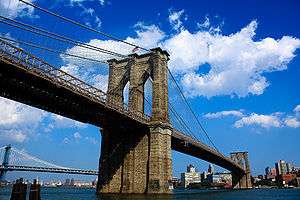
The connections between Queens and Brooklyn are too numerous to mention, because the two boroughs share a land boundary, so almost every street on the border just continues into the other borough. (Prior to 1990, the street signs in each borough had different colors, but they have since all become green - with the exception of brown signs for historic streets - and can no longer be useful in distinguishing between the boroughs.)
The Williamsburg, Manhattan, and Brooklyn Bridges link Manhattan and Brooklyn, and the Verrazano-Narrows Bridge links Staten Island and Brooklyn. Only the Verrazano is a toll bridge. There is also a toll tunnel, the Brooklyn-Battery Tunnel, which links Brooklyn with the Battery (the southern tip of Manhattan).
By foot or bicycle
All the bridges between Brooklyn and Manhattan are now accessible to both pedestrians and cyclists. Prospect Park's main road is closed to cars on weekends and open to bicycles. There are numerous bicycle paths in the park. Along New York Bay to the southwest, there are many sections where one can bicycle. Ocean Parkway also has a bicycle path that runs from Coney Island at the southern end of Brooklyn to the neighborhood of Park Slope.
By ferry
The Water Taxi, at Fulton Ferry Landing, provides service from various points in Manhattan along the East River. The Water Taxi has service between southern Manhattan and Red Hook, often used by customers of the Red Hook Ikea.
Get around
By subway
The subway is overall the best way to get around Brooklyn, although there are some spots, notably Red Hook and parts of East Brooklyn (including most of the tourist attractions), where subway coverage is poor and bus transportation is encouraged. Using Google Maps transit directions is an easy way to get accurate directions throughout Brooklyn (as well as the rest of NYC). However, do check the MTA website for service changes, as Google Maps tends to miss out on those. You can also use the subway map on MTA website or pick one up for free at a station agent's booth.
Brooklyn is well served by some 18 subway lines. The biggest hub is Atlantic Avenue - Barclays Center. There you may transfer to most subway lines in Brooklyn, 2 3 4 5 B D Q N . In addition, the Fulton Street stop on the G line and Lafayette Avenue on the C line are close by, but require exiting and re-entering the subway system (only free if you have an unlimited ride Metrocard). Broadway Junction in Bed-Stuy and East New York is a minor hub between A C J L Z lines, which don't stop at Atlantic Avenue. Transferring there can be useful if you're going to Northern Brooklyn. Coney Island is a major hub for D F N Q lines—it's possible to do a "loop tour" of southern Brooklyn by changing there. For example, taking the D to Coney Island and then the F back to Downtown (both elevated lines) will provide great views of residential Brooklyn.
By bus
Brooklyn has an extensive bus grid that proves very useful in accessing places where subway doesn't stop. The downside is that the buses are much slower than the subway (though not as slow as in Manhattan) and figuring out their route may be confusing. It's highly suggested to have a bus map handy (available free from any subway station agent) or to use Google Maps route planner, which incorporates bus directions very accurately.
As in the rest of New York City, some buses are limited (LTD) service, which means they skip certain stops along the route. However, even non-limited buses won't stop if the "Stop Request" light isn't on and no one is waiting at the bus stop (this is very common). If you plan to get off, make sure you press the "Stop Request" tape/button before you approach your stop, or else the bus may skip it.
By commuter rail
There is the option of taking the Long Island Rail Road if your starting and ending points are in the following neighborhoods: Downtown Brooklyn, near Atlantic Avenue/Flatbush Avenue, Bedford-Stuyvesant, near Atlantic Avenue/Nostrand Avenue, and East New York, near Atlantic Avenue/Van Sinderen Avenue. It isn't terribly convenient, due to the limited stops and relatively infrequent service, but if you need to go to exactly the areas it stops in, it's faster than the subway.
See
See the Districts articles for more listings.
Landmarks
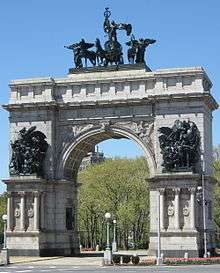
Downtown is where you'll find the one of the most famous of all New York landmarks: the Brooklyn Bridge, which connects the borough to Lower Manhattan.
Grand Army Plaza marks the gateway to Prospect Park, and is home to the distinctive Soldiers and Sailors Arch.
Coney Island is a hotspot during the summer season. One could go for a day and enjoy the beach and beach vendors, then at night visit Luna Park and ride rides for a cheap price or watch a game at the Brooklyn Cyclones baseball field. Among the attractions is the Coney Island Cyclone, one of the world's oldest and still operating wooden roller coasters.
Museums and galleries
Prospect Park is home to the Brooklyn Museum, NYC's second largest art museum. Downtown is home to the New York Transit Museum. Bedford-Stuyvesant and Flatbush are home to the Brooklyn Children's Museum and the Jewish Children's Museum, which is the largest Jewish-themed children's museum in the United States. Williamsburg is home to the Hogar Collection.
Parks and gardens
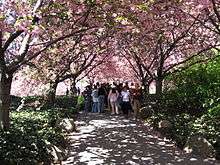
Prospect Park was designed by Olmsted and Vaux, who also designed Manhattan's Central Park but preferred their Brooklyn creation. Adjacent to the park is the Brooklyn Botanic Garden, a 52-acre garden that is home to more than 10,000 taxa of plants. Both are covered in the Prospect Park district article.
Marine Park is a public park that is in the Marine Park neighborhood and surrounds the westernmost inlet of Jamaica Bay. It has about 800 acres and has a bike path, handball court, shuffleboard court and playground. The park is mainly a fertile salt marsh that is supplied with freshwater from Gerritsen Creek.
Do
See the Districts articles for more listings.
Concerts
The Brooklyn Academy of Music and Bargemusic in Downtown are both excellent options for concerts. During the summer season, Prospect Park hosts the Celebrate Brooklyn concert campaign every weekend in the Bandshell area of the park. There are also many concerts at churches and synagogues (for example in Brooklyn Heights and Park Slope), as well as at colleges (such as Brooklyn College and New York Technical College). Check the listings in newspapers like the New York Press and Village Voice, which also have websites.
Sports
Coney Island is home to the Brooklyn Cyclones, the New York Mets' single-A minor league baseball team. Brooklyn is also now home to the Brooklyn Nets NBA team, who play in the Barclays Center in Downtown.
Sightseeing
There are a number of great places to walk for excellent views of Manhattan. Walk across the Brooklyn Bridge—or if you prefer, the Manhattan or Williamsburg Bridge. The Brooklyn Bridge itself is beautiful, and the view is splendid. You can also walk along the Brooklyn Heights Promenade or under the Brooklyn Bridge into the DUMBO neighborhood to get amazing views of Manhattan overlooking the East River.
- 🌍 Adventurer's Family Entertainment Center.,
- 🌍 Deno's Wonder Wheel Amusement Park, 3059 W 12th St, ☎ +1 718-372-2592. The highlight of Coney Island,
- 🌍 Luna Park at Coney Island. - in Brooklyn
Buy
See the Districts articles for more listings.
Eat
See the Districts articles for more listings.
8th Avenue (or Third Chinatown), stretching from 40th Street to 62nd Street, holds its own against Canal Street and Flushing. Fancy gourmet restaurants to alleyway noodle shops, Malaysian to Vietnamese and fare from every Chinese province, the neighborhood has it all. Closest subway is the N-line's '8th Avenue' stop on 62nd and 8th.
Along 7th/5th Avenue in Park Slope, one can find any type of cuisine from Italian, to Mexican, to Japanese and even Fish and Chips. This part of Brooklyn has plenty of Zagat-reviewed restaurants that are sure to please any type of craving and tastebuds.
Drink
See the Districts articles for more listings.
- Williamsburg - This is the capital of NYC's hipster scene. If you like thin pale boys with tight jeans and no job, this is the place for you. There are plenty of bars along Bedford Avenue. Many of New York's small music venues are found here.
- Bay Ridge - This neighborhood has one of the highest concentrations of bars in the city! The neighborhood has been generally Irish/Italian and does not have the hipster/yuppie scene common in New York.
- Park Slope - This neighborhood is the yuppie capital of New York and you are more likely to find a tea house serving soy milk than a bar here. Young couples pushing strollers is a common sight. There is some low-key nightlife, although this has been on the decline. A number of lesbian bars are in this area.
Sleep
See the Districts articles for more listings.
Stay safe
Brooklyn may have a tough reputation, but it is largely quite safe these days. As a rule of thumb, use more caution as you get further east in the borough (especially beyond Utica Avenue), which is where the borough's two worst districts crime-wise are, East New York and Brownsville. You will likely pass through East New York on your way to/from JFK Airport on either the subway or the LIRR. Both rail networks are quite safe as long as you remain within their respective systems (this includes transferring between subway lines at Broadway Junction, which has a transit police office if you're concerned).
Other neighborhoods that one should exercise caution in, in rough order from most to least, are Bushwick, Red Hook (away from the waterfront), Coney Island (away from the amusement parks/beachfront), and East Flatbush.
Connect
Go next
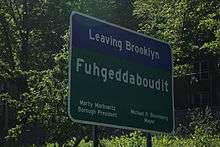
| Routes through Brooklyn |
| Elizabeth ← Staten Island ← | W |
→ Queens → Bronx |
| Ends at |
W |
→ Queens → Freeport |
| END ← | W |
→ Queens → Splits into Babylon, Far Rockaway, and West Hempstead branches |